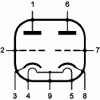Greetings Electrotechies,
I'm brand new to the site and I've got a question / scenario to throw out there. I've had my hands into elecronics for a long time but I'm not terribly familiar with vacuum tubes and their various failure modes.
I have been restoring the power supply & power amplifier chassis from an old console-style Hi-Fi system (circa 1964). The system consists of a tuner/preamplifier up top and the power amplifier/supply in the bottom. Due to it's simplicity, I started with the power chassis.
I have replaced the majority of the small value capacitors except for those that tested fine. I have also added a bunch of filter capacitors on the B+ to compliment the lowly 10uF and 40uF in the original design.
The power amplifier uses a 12AX7 (double triode) amplifying both L&R channels, feeding two separate single-tube stages in class A.
There is a great deal of hum at the speaker output (over a volt p-p) on both channels. If I pull the 12AX7 tube, the noise clears up.
My question is this: Can a failing tube actually introduce hum? If so, where can it be getting the 60 Hz signal from - the filament?
All theories are welcome... Tube guys get on board!
I'm brand new to the site and I've got a question / scenario to throw out there. I've had my hands into elecronics for a long time but I'm not terribly familiar with vacuum tubes and their various failure modes.
I have been restoring the power supply & power amplifier chassis from an old console-style Hi-Fi system (circa 1964). The system consists of a tuner/preamplifier up top and the power amplifier/supply in the bottom. Due to it's simplicity, I started with the power chassis.
I have replaced the majority of the small value capacitors except for those that tested fine. I have also added a bunch of filter capacitors on the B+ to compliment the lowly 10uF and 40uF in the original design.
The power amplifier uses a 12AX7 (double triode) amplifying both L&R channels, feeding two separate single-tube stages in class A.
There is a great deal of hum at the speaker output (over a volt p-p) on both channels. If I pull the 12AX7 tube, the noise clears up.
My question is this: Can a failing tube actually introduce hum? If so, where can it be getting the 60 Hz signal from - the filament?
All theories are welcome... Tube guys get on board!


